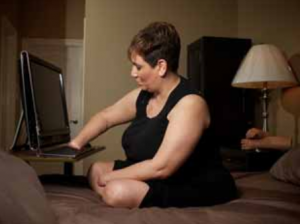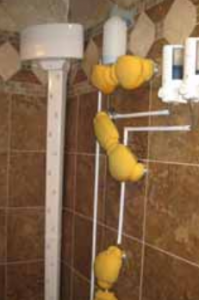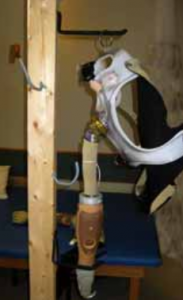Volume 21, Issue 1 January/February 2011 | Download PDF
by Shawn Swanson Johnson, OTR/L
An Occupational Therapist’s Perspective
Upper-limb loss is a rare occurrence. Consider this fact: for every incident of upper-limb amputation, there are 30 incidents of lower-limb amputation. Bilateral upper-limb loss is even rarer, and is extremely challenging, as there is not a remaining arm to perform daily self-care tasks.
The loss or absence of both hands or arms places the individual and his or her family in a very difficult situation. Yet specialized, long-term rehabilitation can help people regain their ability to care for themselves, participate in leisure activities or hobbies, drive a car and return to work. The guidance of a multidisciplinary team that includes both an occupational therapist and a prosthetist who specialize in upper-limb rehabilitation is essential. Other factors that contribute to better outcomes include a strong support system of family and friends and a positive, motivated attitude on the part of the limb-loss individual.
Initial Concerns and Challenges

Bilateral upper-limb patients should be trained how to do tasks both with and without their prostheses
One of the most challenging aspects ofbilateral upper-limb amputation is that for some period of time, the patient is likelyto be completely dependent on someone else for his or her most basic and personal needs. Using the bathroom, bathing, getting dressed and eating are all important aspects to address early on in rehabilitation. Occupational therapy is the best way to start regaining some independence prior to receiving a prosthesis. Occupational therapy also prepares the individual to become a prosthetic user, which will increase his or her options for self-sufficiency. It is important to note that patients should be taught how to perform daily tasks both with and without prostheses. Early occupational therapy in both unilateral and bilateral upper-limb lossa ddresses the following issues: wound care, scar management, edema management, desensitization, range of motion and psychosocial concerns. For bilateral limb-loss individuals, early occupational therapy will also include a unique focus on stretching and strengthening the lower limbs and strengthening the core of the body. Balance and fall recovery are also addressed, as these patients do not have arms to help them with balance or to protect them when they fall. Prior to receiving a prosthesis, there are numerous tools and techniques that can help facilitate independence. These include but are not limited to:
-
A dressing tree can support clothing or prostheses, enabling bilateral upper-limb amputees to get dressed or don their prostheses independently
A universal cuff that slips around the
residual limb and can hold a fork or spoon - Eating utensils that swivel and are easier to grip or provide the appropriate angle to bring food to the mouth
- Bidets, which remove the need for toilet paper management
- Devices such as gooseneck clamps and suction cups to hold personal grooming items like shower brushes, hair dryers and toothbrushes
- A “dressing tree” that makes dressing easier with a system of hooks placed in strategic places on a wooden or PVC stand
- A mouth stick that enables a person to flip switches and press buttons or keyboards
- Speakerphones or voice-activated cell phones
- Electronic, hands-free devices that help the individual call for help and control his or her home environment, such as lighting, room temperature, appliances and TVs.
While these tools are helpful in the home environment, some are not easy to take along when reentering the community or traveling.

Shower modification with wall-mounted sponges for washing the body, soap dispensers controlled by a foot pedal, and a full-body dryer
Getting Familiar With Prosthetics
Becoming a fluent user of bilateral upperlimb prostheses takes time. How much time depends on the complexity of the injury, the length of the residual limbs, and the individual’s overall attitude and level of motivation. It is not unusual for it to take 1 to 2 years or even more to become comfortable and capable.
It is preferable that the prosthetic sockets are preflexed with radial deviations of the forearm and wrist that help position the arms toward the center of the body. Additional components that allow for elbow, wrist or shoulder movements are added to the prosthesis as the individual is able to tolerate the additional weight and complexity.
Prosthetic training for bilateral upperlimb-loss individuals requires a special approach where each arm is trained independently. The residual limb that is longer or more mobile becomes the dominant arm and hand. Prosthetic training should occur on the dominant side first, with the entire process repeated separately on the non-dominant side. Finally, training continues with the individual wearing both prostheses and attempting bimanual daily tasks.
The OT also helps the patient learn to actually use the prostheses in a particular method or sequence of steps that include controls training, repetitive drills and bimanual functional skill retraining. Controls training includes basic movements like opening and closing the terminal device (hand or hook), operating the wrist, flexing and extending the elbow, and manipulating the shoulder joint. After consistency and accuracy are achieved with speed and device positioning, repetitive drills begin. This includes repetitively grasping and releasing items of various shapes and sizes and moving them in different areas around the body. It also includes learning to pre-position the terminal device to pick up objects in an anatomically correct way rather than twisting or bending the body in awkward or harmful ways. After the patient has demonstrated consistency and accuracy with repetitive drills, it is appropriate to move on to bimanual functional skill retraining. This includes basic gross motor skills like folding a towel and progresses to fine motor skills, such as manipulating buttons.
Living in a New Way
Adapting to life with bilateral upper-limb loss usually happens over a period of months or years, not weeks. Smaller day-to-day accomplishments lead to more independence over the long run. If it is financially feasible, home odifications, especially in the bathroom/shower, are extremely beneficial. Smaller day-to-day accomplishments lead to more independence over the long run. If it is financially feasible, home modifications, especially in the bathroom/shower, are extremely beneficial. Smaller modifications around the house, such as changes to drawers, handles, doors, containers and light switches, are easier to make and also less expensive.
Most individuals have a hobby, job or other activity they want to return to. Whether it’s shopping for groceries, working in the yard or driving a car, there are bilateral upper-limb amputees who have found new ways to do these and other activities. Being able to drive again is a reachable goal, and, by working extensively with a driver rehabilitation specialst who has experience with bilateral upper-limb-loss individuals or those with a spinal cord injury, it is often possible to become a licensed driver.
In closing, consider these key points that have emerged from healthcare practitioners over years of working with bilateral upper-limb-loss individuals:
- Most individuals are motivated and inventive/creative in how they adapt.
- Having a strong support system is a vital part of being successful.
- It is essential to have a backup set of arms in the event of repairs and maintenance on the primary prostheses.
- Having multiple terminal devices gives the patient the ability to complete a variety of daily tasks, much like a box of tools is helpful to a handyman.
- Using electric prostheses on both sides is becoming more common, versus the traditional approach of using body-powered on the dominant side and electric on the non-dominant.
- Attendant care is typically required and ranges from part-time to full-time.
- If individuals choose not to wear prostheses and use their feet or other parts of their body for various activities of daily living, anecdotal evidence shows that they will develop problems with their neck, back and especially their hips.
Additional Resources
Workshops
International Society for Prosthetics and Orthotics (ISPO)Skills for Life 3, October 12-16, 2011 The program will feature a series of workshops devoted specifically to issues faced by individuals with bilateral upper-limb loss. Presenters will include therapists, prosthetists, physicians and others living with bilateral upper-limb loss.usispo.org/skills_for_life.asp
Skills for Life 2, Video resrec.com/store search skills for life
Videos The Use of Upper-Extremity Prostheses by Art Heinze armamputee.com
Research Institute of Chicago Video Library: lifecenter.ric.org
click on Videos & Media at the top of the page
Articles in the Amputee Coalition Online Library
(http://catalog.amputee-coalition.org)
Notes From the Medical Director: Grasping the Importance of Our Hands by Douglas G. Smith, MD. Knoxville, TN: Amputee Coalition, 2006.
Notes From the Medical Director: Introduction to UpperLimb Prosthetics: Part 1 by Douglas G. Smith, MD. Knoxville, TN: Amputee Coalition, 2007.
Notes from the Medical Director: Upper-Limb Prosthetics: Part 2: Insights from Those Who Have Lost One Arm by Douglas G. Smith, MD. Knoxville, TN: Amputee Coalition, 2007.
Upper-Limb Prosthetics: Part 3: Insights About the Loss of Both Arms by Douglas G. Smith, MD. Knoxville, TN: Amputee Coalition, 2007.
Upper-Limb Prosthetics: Part 4: Insights About Acquired Loss of Both Arms by Douglas G. Smith, MD. Knoxville, TN: Amputee Coalition, 2008.
Body Dryer
tornadobodydryer.com
Bidets
Toto totousa.com search bidet
Lubidet lubidet.com



